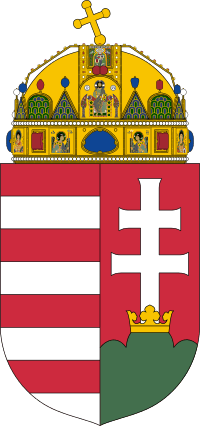Independent Smallholders, Agrarian Workers and Civic Party
| Independent Smallholders, Agrarian Workers and Civic Party Független Kisgazda, Földmunkás és Polgári Párt | |
|---|---|
 | |
| Leader | Péter Hegedüs |
| Founded |
12 October 1930 18 November 1988 (refoundation) |
| Headquarters | 1092. Budapest, Kinizsi u. 22. |
| Ideology |
Agrarianism, Hungarian nationalism, National conservativism |
| Political position | Right-wing |
| European affiliation | None |
| European Parliament group | None |
| Colours | Green |
| Website | |
| www.fkgp.hu | |
|
Politics of Hungary Political parties Elections | |
 |
| This article is part of a series on the politics and government of Hungary |
| Foreign relations |
|
Politics portal |
The Independent Smallholders, Agrarian Workers and Civic Party (Hungarian: Független Kisgazda-, Földmunkás- és Polgári Párt), known mostly by its acronym FKgP or its shortened form Independent Smallholders' Party (Hungarian: Független Kisgazdapárt), is a political party in Hungary. Since 2002 parliamentary elections, the party has won no seats.
History
Founded on 12 October 1930, the original party won an overwhelming majority in the first elections after the Second World War, resulting in its leader, Zoltán Tildy, becoming prime minister. In the relatively free elections in November 1945, the Smallholders' polled 57% of votes against the Communists' 17%. The Communist response was to intensify terror and to sponsor the coalition of "democratic" parties against the "reactionary" smallholders.[1] The Smallholders-dominated parliament established a republic in 1946 with Tildy as president. He was succeeded as prime minister by Ferenc Nagy. However, the Soviet occupation of the country, the Hungarian Communist Party's salami tactic to break up opponent parties and widespread election fraud in 1947 elections led to a communist government.
In 1947 the Communist Party carried out a coup d’état against the rule of the Smallholders’ Party. Though not all democratic institutions were abolished, the Communists firmly held power. Most of the more courageous Smallholder were either arrested or forced to leave the country. Lajos Dinnyés of the Smallholders remained prime minister after the 1947 elections, but his government was controlled by the communists. Over the next two years, the Communists pressured the Smallholders into expelling their more courageous members as "fascists" and fascist sympathizers as part of Communist leader Mátyás Rákosi's "salami tactics". Another Smallholder, the openly pro-Communist István Dobi, became premier in December 1948, and pushed out the remaining elements of the party who weren't willing to do the Communists' bidding. In 1949, the party was absorbed into a People’s Independent Front, led by the communist Hungarian Working People's Party. The latter prevailed in elections held that year, marking the onset of undisguised Communist rule in Hungary. The Smallholders party was dissolved later in 1949, and Dobi and several other left-wing Smallholders joined the Communist Party.
Party leaders (1930–1949; 1988–)
| Leader | Dates |
|---|---|
| Bálint Szijj | 1930–1931 |
| Gaszton Gaál | 1931–1932 |
| Tibor Eckhardt | 1932–1940 |
| Zoltán Tildy | 1940–1944 |
| István Balogh (acting) | 1944–1945 |
| Zoltán Tildy | 1945–1946 |
| Ferenc Nagy | 1946–1947 |
| István Dobi | 1947–1949 |
| Hungary was under one-party rule | 1949–1956 |
| Béla Kovács | 1956 |
| Hungary was under one-party rule | 1956–1988 |
| Tivadar Pártay | 1988–1989 |
| Vince Vörös | 1989–1990 |
| Ferenc József Nagy | 1990–1991 |
| József Torgyán | 1991–2002 |
| Miklós Réti | 2002–2005 |
| Péter Hegedűs | 2005– |
Election results
National Assembly
| Election year | National Assembly | Government | |||
|---|---|---|---|---|---|
| #of overall votes |
% of overall vote |
#of overall seats won |
+/– | ||
| 1931 | 173,477 | |
10 / 245 |
in opposition | |
| 1935 | 387,351 | |
22 / 245 |
|
in opposition |
| 1939 | 569,054 | |
14 / 260 |
|
in opposition |
| 1944 | |
124 / 498 |
|
in government | |
| 1945 | 2,697,262 | |
245 / 409 |
|
in government |
| 1947 | 766,000 | |
68 / 411 |
|
in government |
| 19491 | 5,478,515 | |
62 / 402 |
|
in government |
| 1990 | 576,256 | |
44 / 386 |
in government until 1992 | |
| 1994 | 476,416 | |
26 / 386 |
|
in opposition |
| 1998 | 617,740 | |
48 / 386 |
|
in government |
| 2002 | 42,338 | |
0 / 386 |
|
extra-parliamentary |
| 2006 | 838 | |
0 / 386 |
|
extra-parliamentary |
| 2010 | 381 | |
0 / 386 |
|
extra-parliamentary |
| 2014 | 7,426 | |
0 / 199 |
|
extra-parliamentary |
1FKGP was a member of the Communist-led Hungarian Independence People's Front (MFN). Hungary became a one-party state after the 1949 election.
Notes
- ↑ Laar, M. (2009). "The Power of Freedom. Central and Eastern Europe after 1945." Centre for European Studies, p. 38. http://www.poweroffreedombook.com/preview_PoF.pdf